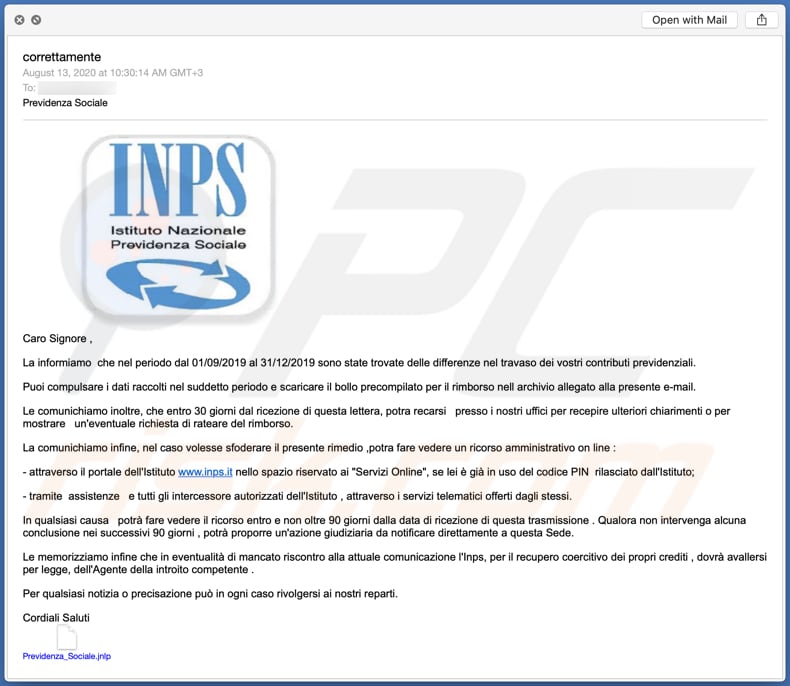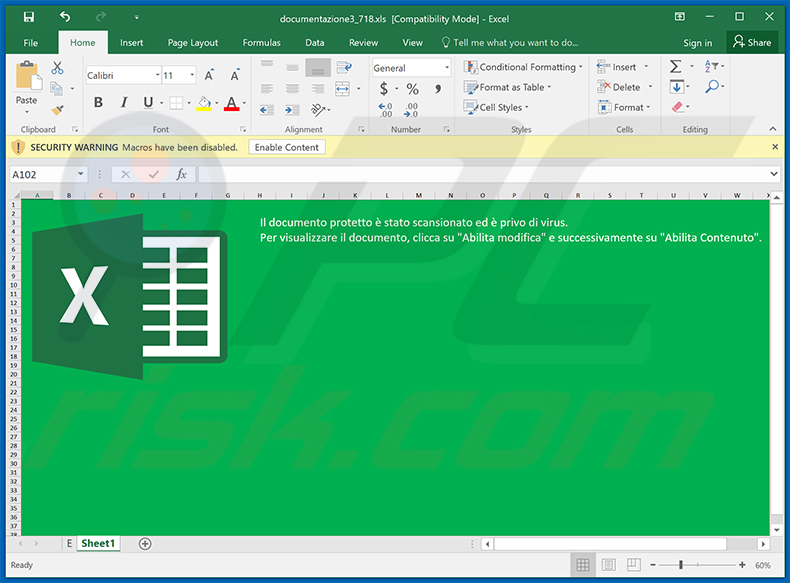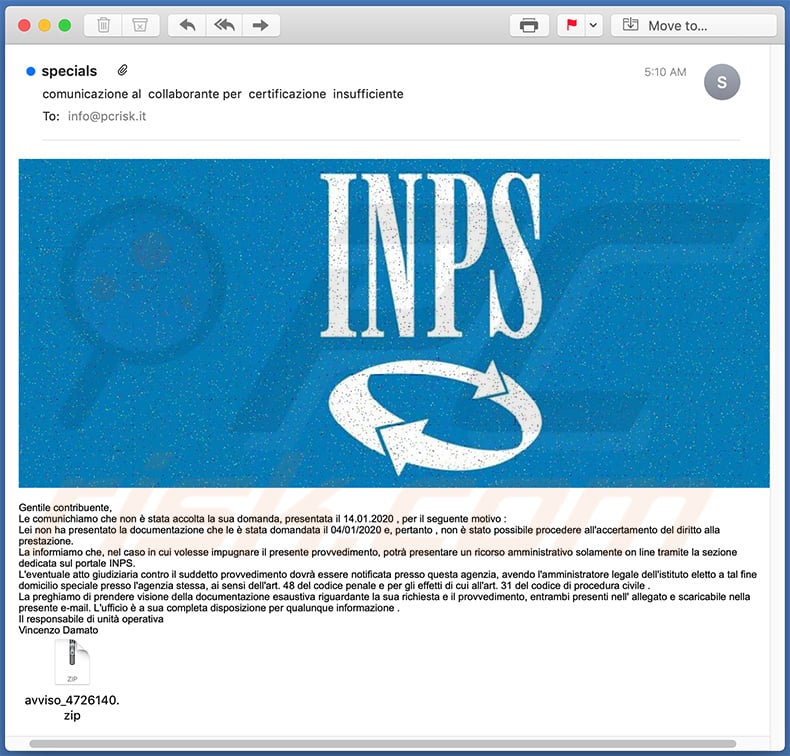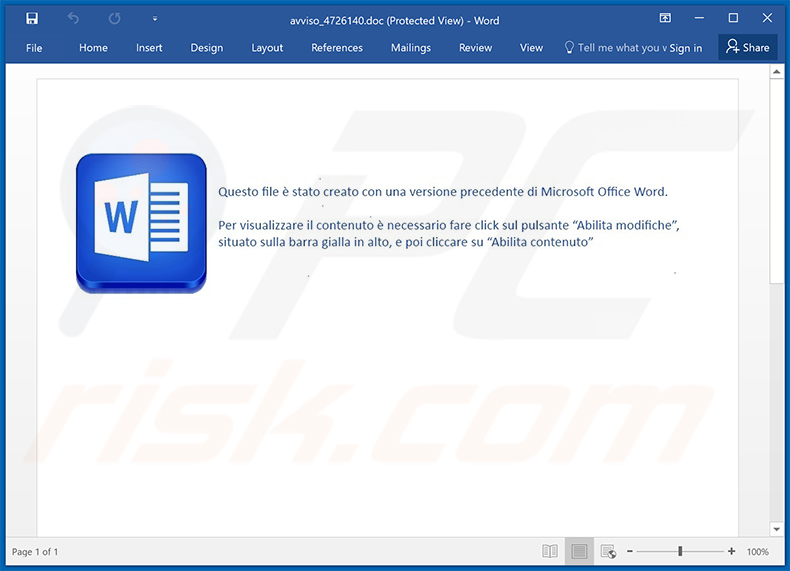Avoid installation of Ursnif via files attached to the INPS malspam campaign
Phishing/ScamAlso Known As: INPS spam
Get free scan and check if your device is infected.
Remove it nowTo use full-featured product, you have to purchase a license for Combo Cleaner. Seven days free trial available. Combo Cleaner is owned and operated by RCS LT, the parent company of PCRisk.com.
What is INPS email virus?
Generally, these emails are sent to deceive recipients into installing malware on their computers through a malicious attachment or website link. In most cases, they are disguised as official messages from legitimate companies and organizations. This email is part of a malspam campaign, which cyber criminals use to trick people into installing Ursnif, a high-risk Trojan.
The email is disguised as a message from INPS, an Italian public agency.

Cyber criminals behind this malspam campaign send emails claiming that some differences were found in the transfer of the recipient's social security contributions and offer to make a request for reimbursement. Their main goal is to deceive the recipient into opening the attached JNLP file named "Previdenza_Sociale.jnlp", which installs Ursnif.
This Trojan can collect saved logins/passwords, web browsing activity, system information, log keystrokes, steal and/or clear cookies, reboot the system, take screenshots. It can also be used to download and execute files.
In this way, cyber criminals can use Ursnif to steal identities, credit card details, login credentials (usernames, email addresses, passwords) and use stolen data to trick other people into paying them, making fraudulent purchases and transactions, spreading this or other malspam further, and for other malicious purposes.
Since this Trojan can be used to execute downloaded files, cyber criminals can employ this feature to infect the computer with other malware. For example, other Trojans, ransomware, cryptocurrency miners, etc. Therefore, ignore these emails and do not open attachments or website links within them.
| Name | INPS spam |
| Threat Type | Trojan, password-stealing virus, banking malware, spyware. |
| Hoax | This email is disguised as an official letter from Italian public agency |
| Attachment(s) | Previdenza_Sociale.jnlp (its name may vary) |
| Symptoms | Trojans are designed to stealthily infiltrate the victim's computer and remain silent, and thus no particular symptoms are clearly visible on an infected machine. |
| Payload | Ursnif |
| Distribution methods | Infected email attachments, malicious online advertisements, social engineering, software 'cracks'. |
| Damage | Stolen passwords and banking information, identity theft, the victim's computer added to a botnet. |
| Malware Removal (Windows) |
To eliminate possible malware infections, scan your computer with legitimate antivirus software. Our security researchers recommend using Combo Cleaner. Download Combo CleanerTo use full-featured product, you have to purchase a license for Combo Cleaner. 7 days free trial available. Combo Cleaner is owned and operated by RCS LT, the parent company of PCRisk.com. |
In summary, most malspam campaigns contain a attachment or website link that, if opened, causes download of a malicious file or installation of malware. More examples of malspam campaigns are "COELECSA Email Virus", "Ptt Email Virus" and "ABB Email Virus".
Generally, they are disguised as official messages from well-known, legitimate companies and organizations. Some examples of other malicious programs that cyber criminals distribute through malspam are Agent Tesla, HawkEye, Taurus and TrickBot.
How did "INPS Email Virus" infect my computer?
Ursnif is installed only when recipients open the attached Previdenza_Sociale.jnlp file (it might have a different name in other versions of this malspam campaign).
More examples of files that cyber criminals attach to emails when they attempt to trick recipients into installing malware are malicious Microsoft Office documents, executable files (.exe), archive files (ZIP, RAR), PDF documents, JavaScript files. Usually a rogue program is installed only after execution of the malicious file.
Malicious MS Office documents require permission to enable content (macros commands) to install malware, however, this applies only to MS Office 2010 and later versions. Older versions do not include "Protected View" mode and infect computers automatically.
How to avoid installation of malware
Attachments or links in irrelevant emails that are sent from suspicious, unknown addresses should not be opened. The emails are used by cyber criminals to deceive recipients into installing malware onto their computers. Software should be downloaded only from official websites and through direct links.
It is not safe to use other sources/tools such as Peer-to-Peer networks (e.g., torrent clients, eMule), unofficial pages, third party downloaders, etc. Third party installers should also be avoided. Operating systems and installed programs must be updated with tools or implemented functions designed/provided by official software developers.
Unofficial, third party activation ('cracking') and updating tools often install malware. Furthermore, it is illegal to activate licensed software with unofficial tools. Finally, computers should be regularly scanned with reputable antivirus or anti-spyware software. Keep this software up to date.
If you have already opened "INPS Email Virus" attachment, we recommend running a scan with Combo Cleaner Antivirus for Windows to automatically eliminate infiltrated malware.
Text presented in the "INPS Email Virus" email message:
Subject: Previdenza Sociale
Caro Signore ,
La informiamo che nel periodo dal 01/09/2019 al 31/12/2019 sono state trovate delle differenze nel travaso dei vostri contributi previdenziali.
Puoi compulsare i dati raccolti nel suddetto periodo e scaricare il bollo precompilato per il rimborso nell archivio allegato alla presente e-mail.
Le comunichiamo inoltre, che entro 30 giorni dal ricezione di questa lettera, potra recarsi presso i nostri uffici per recepire ulteriori chiarimenti o per mostrare un'eventuale richiesta di rateare del rimborso.
La comunichiamo infine, nel caso volesse sfoderare il presente rimedio ,potra fare vedere un ricorso amministrativo on line :
- attraverso il portale dell'Istituto www.inps.it nello spazio riservato ai "Servizi Online", se lei è già in uso del codice PIN rilasciato dall'Istituto;
- tramite assistenze e tutti gli intercessore autorizzati dell'Istituto , attraverso i servizi telematici offerti dagli stessi.
In qualsiasi causa potrà fare vedere il ricorso entro e non oltre 90 giorni dalla data di ricezione di questa trasmissione . Qualora non intervenga alcuna conclusione nei successivi 90 giorni , potrà proporre un'azione giudiziaria da notificare direttamente a questa Sede.
Le memorizziamo infine che in eventualità di mancato riscontro alla attuale comunicazione l'Inps, per il recupero coercitivo dei propri crediti , dovrà avallersi per legge, dell'Agente della introito competente .
Per qualsiasi notizia o precisazione può in ogni caso rivolgersi ai nostri reparti.
Cordiali Saluti
Example of a malicious MS Excel document (used to inject Ursnif) distributed via INPS spam emails:

Another example of an INPS-themed spam email used to spread Ursnif (Gozi) Trojan:

Text presented within:
Subject: comunicazione al collaborante per certificazione insufficiente
Gentile contribuente,
Le comunichiamo che non è stata accolta la sua domanda, presentata il 14.01.2020 , per il seguente motivo :
Lei non ha presentato la documentazione che le è stata domandata il 04/01/2020 e, pertanto , non è stato possibile procedere all'accertamento del diritto alla prestazione.
La informiamo che, nel caso in cui volesse impugnare il presente provvedimento, potrà presentare un ricorso amministrativo solamente on line tramite la sezione dedicata sul portale INPS.
L'eventuale atto giudiziaria contro il suddetto provvedimento dovrà essere notificata presso questa agenzia, avendo l'amministratore legale dell'istituto eletto a tal fine domicilio speciale presso l'agenzia stessa, ai sensi dell'art. 48 del codice penale e per gli effetti di cui all'art. 31 del codice di procedura civile .
La preghiamo di prendere visione della documentazione esaustiva riguardante la sua richiesta e il provvedimento, entrambi presenti nell' allegato e scaricabile nella presente e-mail. L'ufficio è a sua completa disposizione per qualunque informazione .
Il responsabile di unità operativa
Vincenzo Damato
Screenshot of the attached malicious MS Word attachment designed to inject Ursnif (Gozi):

Instant automatic malware removal:
Manual threat removal might be a lengthy and complicated process that requires advanced IT skills. Combo Cleaner is a professional automatic malware removal tool that is recommended to get rid of malware. Download it by clicking the button below:
DOWNLOAD Combo CleanerBy downloading any software listed on this website you agree to our Privacy Policy and Terms of Use. To use full-featured product, you have to purchase a license for Combo Cleaner. 7 days free trial available. Combo Cleaner is owned and operated by RCS LT, the parent company of PCRisk.com.
Quick menu:
- What is INPS spam?
- Types of malicious emails.
- How to spot a malicious email?
- What to do if you fell for an email scam?
Types of malicious emails:
![]() Phishing Emails
Phishing Emails
Most commonly, cybercriminals use deceptive emails to trick Internet users into giving away their sensitive private information, for example, login information for various online services, email accounts, or online banking information.
Such attacks are called phishing. In a phishing attack, cybercriminals usually send an email message with some popular service logo (for example, Microsoft, DHL, Amazon, Netflix), create urgency (wrong shipping address, expired password, etc.), and place a link which they hope their potential victims will click on.
After clicking the link presented in such email message, victims are redirected to a fake website that looks identical or extremely similar to the original one. Victims are then asked to enter their password, credit card details, or some other information that gets stolen by cybercriminals.
![]() Emails with Malicious Attachments
Emails with Malicious Attachments
Another popular attack vector is email spam with malicious attachments that infect users' computers with malware. Malicious attachments usually carry trojans that are capable of stealing passwords, banking information, and other sensitive information.
In such attacks, cybercriminals' main goal is to trick their potential victims into opening an infected email attachment. To achieve this goal, email messages usually talk about recently received invoices, faxes, or voice messages.
If a potential victim falls for the lure and opens the attachment, their computers get infected, and cybercriminals can collect a lot of sensitive information.
While it's a more complicated method to steal personal information (spam filters and antivirus programs usually detect such attempts), if successful, cybercriminals can get a much wider array of data and can collect information for a long period of time.
![]() Sextortion Emails
Sextortion Emails
This is a type of phishing. In this case, users receive an email claiming that a cybercriminal could access the webcam of the potential victim and has a video recording of one's masturbation.
To get rid of the video, victims are asked to pay a ransom (usually using Bitcoin or another cryptocurrency). Nevertheless, all of these claims are false - users who receive such emails should ignore and delete them.
How to spot a malicious email?
While cyber criminals try to make their lure emails look trustworthy, here are some things that you should look for when trying to spot a phishing email:
- Check the sender's ("from") email address: Hover your mouse over the "from" address and check if it's legitimate. For example, if you received an email from Microsoft, be sure to check if the email address is @microsoft.com and not something suspicious like @m1crosoft.com, @microsfot.com, @account-security-noreply.com, etc.
- Check for generic greetings: If the greeting in the email is "Dear user", "Dear @youremail.com", "Dear valued customer", this should raise suspiciousness. Most commonly, companies call you by your name. Lack of this information could signal a phishing attempt.
- Check the links in the email: Hover your mouse over the link presented in the email, if the link that appears seems suspicious, don't click it. For example, if you received an email from Microsoft and the link in the email shows that it will go to firebasestorage.googleapis.com/v0... you shouldn't trust it. It's best not to click any links in the emails but to visit the company website that sent you the email in the first place.
- Don't blindly trust email attachments: Most commonly, legitimate companies will ask you to log in to their website and to view any documents there; if you received an email with an attachment, it's a good idea to scan it with an antivirus application. Infected email attachments are a common attack vector used by cybercriminals.
To minimise the risk of opening phishing and malicious emails we recommend using Combo Cleaner Antivirus for Windows.
Example of a spam email:

What to do if you fell for an email scam?
- If you clicked on a link in a phishing email and entered your password - be sure to change your password as soon as possible. Usually, cybercriminals collect stolen credentials and then sell them to other groups that use them for malicious purposes. If you change your password in a timely manner, there's a chance that criminals won't have enough time to do any damage.
- If you entered your credit card information - contact your bank as soon as possible and explain the situation. There's a good chance that you will need to cancel your compromised credit card and get a new one.
- If you see any signs of identity theft - you should immediately contact the Federal Trade Commission. This institution will collect information about your situation and create a personal recovery plan.
- If you opened a malicious attachment - your computer is probably infected, you should scan it with a reputable antivirus application. For this purpose, we recommend using Combo Cleaner Antivirus for Windows.
- Help other Internet users - report phishing emails to Anti-Phishing Working Group, FBI’s Internet Crime Complaint Center, National Fraud Information Center and U.S. Department of Justice.
Share:

Tomas Meskauskas
Expert security researcher, professional malware analyst
I am passionate about computer security and technology. I have an experience of over 10 years working in various companies related to computer technical issue solving and Internet security. I have been working as an author and editor for pcrisk.com since 2010. Follow me on Twitter and LinkedIn to stay informed about the latest online security threats.
PCrisk security portal is brought by a company RCS LT.
Joined forces of security researchers help educate computer users about the latest online security threats. More information about the company RCS LT.
Our malware removal guides are free. However, if you want to support us you can send us a donation.
DonatePCrisk security portal is brought by a company RCS LT.
Joined forces of security researchers help educate computer users about the latest online security threats. More information about the company RCS LT.
Our malware removal guides are free. However, if you want to support us you can send us a donation.
Donate
▼ Show Discussion